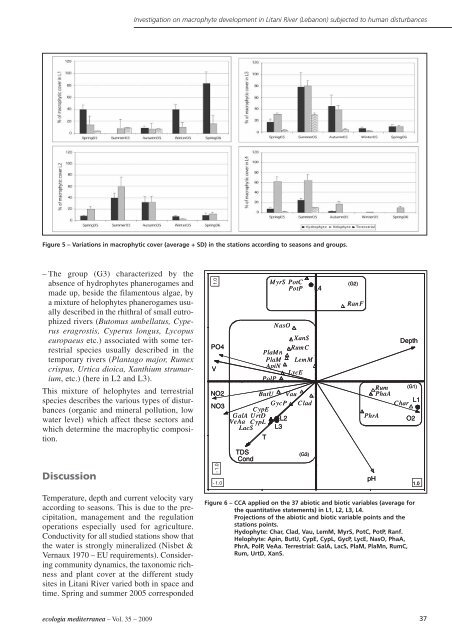Vol. 35 – 2009 - Ecologia Mediterranea - Université d'Avignon et des ...
Vol. 35 – 2009 - Ecologia Mediterranea - Université d'Avignon et des ...
Vol. 35 – 2009 - Ecologia Mediterranea - Université d'Avignon et des ...
You also want an ePaper? Increase the reach of your titles
YUMPU automatically turns print PDFs into web optimized ePapers that Google loves.
<strong>–</strong> The group (G3) characterized by the<br />
absence of hydrophytes phanerogames and<br />
made up, beside the filamentous algae, by<br />
a mixture of helophytes phanerogames usually<br />
<strong>des</strong>cribed in the rhithral of small eutrophized<br />
rivers (Butomus umbellatus, Cyperus<br />
eragrostis, Cyperus longus, Lycopus<br />
europaeus <strong>et</strong>c.) associated with some terrestrial<br />
species usually <strong>des</strong>cribed in the<br />
temporary rivers (Plantago major, Rumex<br />
crispus, Urtica dioica, Xanthium strumarium,<br />
<strong>et</strong>c.) (here in L2 and L3).<br />
This mixture of helophytes and terrestrial<br />
species <strong>des</strong>cribes the various types of disturbances<br />
(organic and mineral pollution, low<br />
water level) which affect these sectors and<br />
which d<strong>et</strong>ermine the macrophytic composition.<br />
Discussion<br />
Temperature, depth and current velocity vary<br />
according to seasons. This is due to the precipitation,<br />
management and the regulation<br />
operations especially used for agriculture.<br />
Conductivity for all studied stations show that<br />
the water is strongly mineralized (Nisb<strong>et</strong> &<br />
Vernaux 1970 <strong>–</strong> EU requirements). Considering<br />
community dynamics, the taxonomic richness<br />
and plant cover at the different study<br />
sites in Litani River varied both in space and<br />
time. Spring and summer 2005 corresponded<br />
ecologia mediterranea <strong>–</strong> <strong>Vol</strong>. <strong>35</strong> <strong>–</strong> <strong>2009</strong><br />
Investigation on macrophyte development in Litani River (Lebanon) subjected to human disturbances<br />
Figure 5 <strong>–</strong> Variations in macrophytic cover (average + SD) in the stations according to seasons and groups.<br />
1.0<br />
PO4<br />
V<br />
NO2<br />
NO3<br />
- 1.0<br />
- 1.0<br />
MyrS PotC<br />
PotP<br />
NasO<br />
PlaMn<br />
PlaM<br />
ApiN<br />
PolP<br />
XanS<br />
RumC<br />
LemM<br />
LycE<br />
ButU Vau<br />
GycP<br />
CypE<br />
GalA UrtD<br />
VeAa<br />
L2<br />
CypL<br />
LacS L3<br />
T<br />
Clad<br />
TDS<br />
Cond<br />
(G3)<br />
RanF<br />
PhrA<br />
Rum (G1)<br />
PhaA<br />
Char<br />
L1<br />
Figure 6 <strong>–</strong> CCA applied on the 37 abiotic and biotic variables (average for<br />
the quantitative statements) in L1, L2, L3, L4.<br />
Projections of the abiotic and biotic variable points and the<br />
stations points.<br />
Hydophyte: Char, Clad, Vau, LemM, MyrS, PotC, PotP, Ranf.<br />
Helophyte: Apin, ButU, CypE, CypL, GycP, LycE, NasO, PhaA,<br />
PhrA, PolP, VeAa. Terrestrial: GalA, LacS, PlaM, PlaMn, RumC,<br />
Rum, UrtD, XanS.<br />
L4<br />
(G2)<br />
pH<br />
Depth<br />
O2<br />
1.0<br />
37
















